NASA Astronaut Group 2
NASA Astronaut Group 2, also known as the New Nine and the Next Nine, was the second group of astronauts selected by NASA. Their selection was announced on September 17, 1962. The nine astronauts were Neil Armstrong, Frank Borman, Pete Conrad, Jim Lovell, James McDivitt, Elliot See, Tom Stafford, Ed White and John Young. Six of the nine flew to the Moon (Lovell and Young twice), and Armstrong, Conrad and Young walked on it as well. Seven of the nine were awarded the Congressional Space Medal of Honor.
| New Nine | |
|---|---|
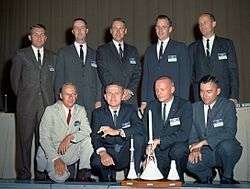 Group 2 astronauts. Back row: See, McDivitt, Lovell, White, Stafford. Front row: Conrad, Borman, Armstrong, Young. Before them are models of the Mercury, Apollo and Gemini spacecraft. | |
| Year selected | 1962 |
| Number selected | 9 |
The group was required to augment the original Mercury Seven, with the announcement of the Gemini program leading to the Apollo program. While the Original Seven had been selected to accomplish the simpler task of orbital flight, the new challenges of rendezvous and lunar landing led to the selection of candidates with advanced engineering degrees (for four of the nine) as well as test pilot experience. Lovell and Conrad had been candidates for the Original Seven, but were not selected then. The nine became the first group with civilian test pilots; See had flown for General Electric, while Armstrong had flown the X-15 research plane for NASA.
Background

NASA's selection of the first American astronauts for Project Mercury, known as the "Original Seven" or "Mercury Seven",[1] was announced on April 9, 1959.[2] President John F. Kennedy announced on May 25, 1961 the goal of putting a man on the Moon by the end of the decade,[3] which gave direction to the Apollo program.[4] NASA formally announced a two-man spacecraft between Mercury and Apollo on December 7, 1961, and on January 3, 1962 it was officially named Project Gemini.[5]
On April 18, 1962, NASA formally announced that it was accepting applications for a new group of astronauts who would assist the Mercury astronauts with Project Mercury, and join them in flying Project Gemini missions. It was anticipated that they might go on to command Project Apollo missions. Unlike the selection process for the Mercury Seven, which was carried out in secret, this selection was widely advertised, with public announcements and the minimum standards communicated to aircraft companies, government agencies and the Society of Experimental Test Pilots.[6]
Selection criteria
Right now, in the beginning, we are picking experienced test pilots, not because they are fighter pilots, but because they have experience in dealing with new machines, unusual situations, being scared to death yet reacting properly. We're not saying for a minute that no one except test pilots has this experience. But this group also has the engineering background that we're looking for to get our programs started.
The five minimum selection criteria were that applicants:
- were experienced test pilots, with 1,500 hours test pilot flying time, who had graduated from a military test pilot school, or had test pilot experience with NASA or the aircraft industry;
- had flown high-performance jet aircraft;
- had earned a degree in engineering or the physical or biological sciences;
- were a U.S. citizen, under 35 years of age, and 6 feet 0 inches (1.83 m) or less in height; and
- recommended by employer.[6][8]
The criteria differed from those of the Mercury Seven selection in several ways. The Gemini spacecraft was expected to be more capacious than the Mercury one, so the height requirement was relaxed slightly. This made Thomas P. Stafford eligible. A college degree was now required, but could be in the biological sciences. Civilian test pilots were now eligible, but the requirement for experience in high-performance jets favoured those with recent experience, and fighter pilots over those with multi-engine experience such as Scott Carpenter of the Mercury Seven. Perhaps the most important change was lowering the age limit from 40 to 35. This was because whereas Mercury was a short-term project, Project Apollo was going to run until the end of the decade at least. The changed selection criteria meant that the selection panel could not simply select another group from the Mercury Seven finalists.[7][8][9]
Jerrie Cobb advocated for women to be allowed to become astronauts, and the Mercury 13 had passed the same medical tests given to the Mercury Seven astronauts.[10] Although women were not prevented from applying, the requirement for jet test pilot experience effectively excluded them. NASA Administrator James E. Webb said "I do not think we shall be anxious to put a woman or any other person of particular race or creed into orbit just for the purpose or putting them there".[11]
Selection process
The U.S. Navy (USN) and U.S. Marine Corps (USMC) submitted the names of all their pilots who met the selection criteria, but the U.S. Air Force (USAF) conducted its own internal selection process, and only submitted the names of eleven candidates.[12] The Air Force ran them through a brief training course in May 1962 on how to speak and conduct themselves during the NASA selection process. The candidates called it a "charm school".[13] The Chief of Staff of the Air Force, General Curtis LeMay, told them: "There are a lot of people who'll say you're deserting the Air Force if you're accepted into NASA. Well, I'm the Chief of the Air Force and I want you to know I want you in this program. I want you to succeed in it, and that's your Air Force mission. I can't think of anything more important."[14]
In all, 253 applications were received by the June 1, 1962, deadline.[9] Neil Armstrong submitted his application a week after the deadline, but Walter C. Williams, the associate director of the Space Task Group, wanted the NASA test pilot, so he had Richard Day, who acted as secretary of the selection panel, add it to the pile of applications when it arrived. Paul Bikle, the director of the NASA's Flight Research Center, declined to recommend Armstrong for astronaut selection because he had misgivings about Armstrong's performance.[15]
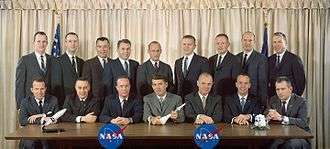
The three-person selection panel consisted of Mercury Seven astronauts Alan Shepard and Deke Slayton, and NASA test pilot Warren J. North, although Williams sat in on some sessions.[16] They reduced the candidates to a more manageable 32 finalists,[17] from whom they hoped to select between five and ten new astronauts.[11] The Air Force's pre-selection process seems to have been successful; nine of the eleven were chosen as finalists, and one of those rejected, Joe Engle, was selected in a later intake in 1966.[12] Of the rest, thirteen were from the Navy, four were Marines, and six were civilians.[17] Four had been finalists in the Mercury Seven selection: Pete Conrad, Jim Lovell, John Mitchell and Robert Solliday.[18] Lovell was not selected for the Mercury Seven due to a high bilirubin blood count.[19]
The finalists were sent to Brooks Air Force Base in San Antonio for medical examinations. The tests there were much the same as those employed to select the Mercury Seven.[20] One candidate, Lieutenant Commander Carl (Tex) Birdwell, was found to be 2 inches (5 cm) too tall.[21] Another four were eliminated on the basis of ear, nose and throat examinations.[22] The remaining 27 then went to Ellington Air Force Base near Houston, where the Manned Spacecraft Center (MSC) was being established. They were individually interviewed by the selection panel.[23]
Nine candidates were selected, and their names forwarded to Gilruth for approval. Slayton informed each of them by phone on September 14.[24] The nine arrived in Houston on September 15. To avoid tipping off the media, all checked into the Rice Hotel in Houston under the name of Max Peck, its general manager.[25] On September 17, the media crowded into the 1800-seat Cullen auditorium at the University of Houston for the official announcement, but it was a more low-key event than the unveiling of the Mercury Seven three years before.[26]
As with those who had been passed over in the Mercury Seven selection, most of the rejected finalists went on to have distinguished careers. William E. Ramsey became a vice admiral in the Navy, and Kenneth Weir, a major general in the Marine Corps.[18] Four would become NASA astronauts in later selections: Alan Bean, Michael Collins and Richard Gordon in 1963, and Jack Swigert in 1966.[27]
Demographics
The nine astronauts were Neil Armstrong, Frank Borman, Pete Conrad, Jim Lovell, James McDivitt, Elliot See, Tom Stafford, Ed White and John Young. Conrad, Lovell and Young were from the Navy; Borman, McDivitt, Stafford and White from the Air Force; and Armstrong and See were civilians.[28] All were male and white, married with an average of two children. Their average age was 32.5, two years younger than the Mercury Seven at the time of selection. They had an average of 2,800 flying hours each, 1,900 of them in jets.[29] This was 700 fewer flying hours than the Mercury Seven, but 200 more hours in jets. Their average weight was slightly higher — 161.5 pounds (73.3 kg) compared to 159 pounds (72 kg).[30]
All had college education. Three had master's degrees: Borman had a Master of Science degree in aeronautical engineering from the California Institute of Technology, See had one from the University of California at Los Angeles, and White had one from University of Michigan. Armstrong, Conrad, McDivitt and Young all had engineering degrees, and Lovell and Stafford had science degrees from the United States Naval Academy.[31] Their mean IQ was 132.1 on the Wechsler Adult Intelligence Scale.[32] Borman and McDivitt were early graduates of the USAF Aerospace Research Pilot School (ARPS).[24]
Group members
| Image | Name | Born | Died | Career | ref |
|---|---|---|---|---|---|
.jpg) |
Neil A. Armstrong | Wapakoneta, Ohio, August 5, 1930 |
August 25, 2012 | Armstrong graduated from Purdue University with a Bachelor of Science degree in aeronautical engineering in 1955. He flew 78 combat missions in the Korean War as a naval aviator, and then became a test pilot for the National Advisory Committee for Aeronautics (the forerunner of NASA) at the High-Speed Flight Station at Edwards Air Force Base, where he flew the X-15. He made his first spaceflight as commander of Gemini 8 in March 1966, becoming NASA's first civilian astronaut to fly in space. During this mission with pilot David Scott, he performed the first docking of two spacecraft, but the mission was aborted after Armstrong used some of his re-entry control fuel to remove a dangerous roll caused by a stuck thruster. During training for his second and last spaceflight as commander of Apollo 11, he ejected from the Lunar Landing Research Vehicle moments before a crash. In July 1969, he and his lunar module pilot, Buzz Aldrin, became the first people to land on the Moon, and spent two and a half hours outside the spacecraft. He earned a Master of Science degree in aerospace engineering from the University of Southern California in 1970. He resigned from NASA in 1971, and taught aerospace engineering at the University of Cincinnati until 1979. He served on the Apollo 13 accident investigation, and on the Rogers Commission, which investigated the Space Shuttle Challenger disaster. | [30][33] |
.jpg) |
Frank F. Borman II | Gary, Indiana, March 14, 1928 |
Borman received a Bachelor of Science degree from the United States Military Academy at West Point, in 1950. He joined the USAF and became a fighter pilot. He earned a Master of Science degree in aeronautical engineering from the California Institute of Technology in 1957. He was an assistant professor of thermodynamics and fluid mechanics at West Point from 1957 to 1960. He graduated from the USAF Experimental Test Pilot School with Class 60-C, and from the ARPS with Class I. He was initially selected for Gemini 5 with Gus Grissom, but Grissom was moved to Gemini 3, with Young as his pilot. Borman commanded the Gemini 7 mission in December 1965. On this mission he and Lovell spent two weeks in space, and performed the first space rendezvous with Gemini 6A. After the Apollo 1 fire he was the astronaut representative on the accident investigation board. In December 1968, he commanded Apollo 8, the first crewed circumlunar mission. He retired from NASA and the USAF in 1970, and joined Eastern Airlines, eventually becoming its Chairman of the Board in December 1976, eventually retiring in 1986. | [30][34][35][36] | |
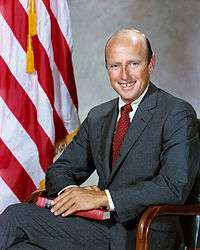 |
Charles Conrad Jr. | Philadelphia, Pennsylvania, June 2, 1930 |
July 8, 1999 | Conrad graduated from Princeton University in 1953 with a Bachelor of Science degree in aeronautical engineering. He joined the Navy and became a naval aviator. In 1958, he graduated from the United States Naval Test Pilot School at Naval Air Station Patuxent River, Patuxent, Maryland as part of Class 20. He set an eight-day space endurance record along with his command pilot Gordon Cooper on his first spaceflight, the Gemini 5 mission in August 1965. The following year he commanded the Gemini 11 mission, on which he and pilot Dick Gordon set an altitude record of 850 miles (1,370 km). He became the third person to walk on the Moon as commander of Apollo 12 in 1969 after landing the lunar module Intrepid in the Ocean of Storms. He and pilot Alan Bean made two moonwalks, recovering components from the Surveyor 3 probe, which had landed there two years before. In 1973 he commanded Skylab 2, the first crewed Skylab mission, and spent 28 more days in space. On this mission, he and his crewmates repaired significant launch damage to the Skylab space station.[37] | [30][34] |
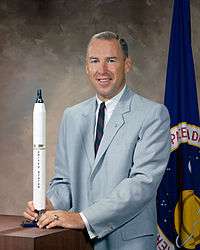 |
James A. Lovell Jr. | Cleveland, Ohio, March 25, 1928 |
Lovell graduated with a Bachelor of Science degree from the United States Naval Academy at Annapolis, Maryland with the Class of 1952, and became a naval aviator. In 1958, he graduated from the United States Naval Test Pilot School with Class 20. He flew as the pilot of the Gemini 7 mission in December 1965 during which he and Borman spent two weeks in space, and conducted the first rendezvous in space, with Gemini 6A. In November 1966 he commanded the Gemini 12 mission with Buzz Aldrin as his pilot. He was the command module pilot on the Apollo 8 mission in December 1968, during which he, Borman and Bill Anders conducted the first crewed circumlunar mission. In April 1970 he became the first person fly in space four times, and the first to travel to the Moon twice, on the ill-fated Apollo 13 mission. | [30][38] | |
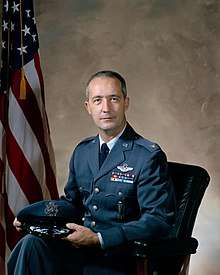 |
James A. McDivitt | Chicago, Illinois, June 10, 1929 |
McDivitt joined the USAF in 1951, and flew 145 combat missions in the Korean War. He received a Bachelor of Science degree in aeronautical engineering from the University of Michigan, graduating first in class in 1959. That year he also graduated from the USAF Experimental Test Pilot School with Class 59-C, and he graduated from the ARPS with Class I in 1960. He commanded the Gemini 4 mission during which White performed the first U.S. spacewalk. He was the first astronaut to command his first space mission. In March 1969, he commanded the Apollo 9 flight, which was the first crewed flight test of the Lunar Module and the complete set of Apollo flight hardware. He later became Manager of Lunar Landing Operations and was the Apollo Spacecraft Program Manager from 1969 to 1972. In February 1972 he was promoted to the rank of brigadier general, the first astronaut to reach that rank. He retired from NASA and the USAF later that year to pursue a career in the aviation industry, and became a senior vice president at Rockwell International. | [30][39] | |
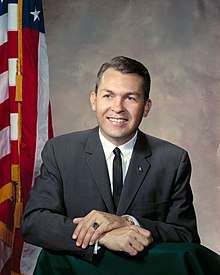 |
Elliot M. See, Jr | Dallas, Texas, July 23, 1927 |
February 28, 1966 | See graduated from the United States Merchant Marine Academy (USMMA) in 1949 with a Bachelor of Science degree in marine engineering, and a commission in the United States Naval Reserve. That year he joined General Electric. He served on active duty with the U.S. Navy from 1953 to 1956, then rejoined General Electric, becoming a test pilot. He earned a Master of Science degree in aeronautical engineering from the University of California in Los Angeles in 1962. See was chosen as the command pilot of Gemini 9, but died in a T-38 plane crash less than four months before launch. | [30][40] |
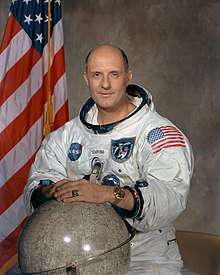 |
Thomas P. Stafford | Weatherford, Oklahoma, September 17, 1930 |
Stafford graduated with a Bachelor of Science from the United States Naval Academy at Annapolis, Maryland with the Class of 1952, and joined the USAF. He graduated from the USAF Experimental Test Pilot School with Class 58-C. He made his first spaceflight in December 1965 as the pilot of Gemini 6A, which made the first space rendezvous, with Gemini 7. In June of the following year he commanded Gemini 9A. In 1969, Stafford was the Commander of Apollo 10, the second crewed mission to orbit the Moon and the first to fly a Lunar Module in lunar orbit, descending to an altitude of 9 miles (14 km) above its surface. On the return to Earth, the Apollo 10 spacecraft achieved a speed of 24,791 miles per hour (39,897 km/h), setting the record for the fastest speed achieved by human beings. In 1975, Stafford was the commander of the Apollo-Soyuz Test Project flight, the first joint U.S.-Soviet space mission. He was a brigadier general at the time of the mission, becoming the first general officer to fly in space, as well as the first member of his Naval Academy class to pin on the first, second, and third stars of a general officer. | [30][41][42] | |
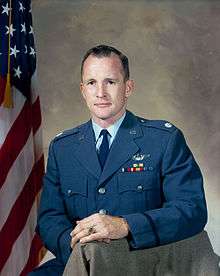 |
Edward H. White II | San Antonio, Texas, November 14, 1930 |
January 27, 1967 | White received a Bachelor of Science degree from the United States Military Academy at West Point, graduating with the Class of 1952. He joined the USAF and became a fighter pilot. He earned a Master of Science degree in aeronautical engineering from the University of Michigan in 1959. He graduated from the USAF Experimental Test Pilot School with Class 59-C. In June 1965, he flew on Gemini 4 as its pilot, and conducted the first American spacewalk. He was selected as the Command Module pilot of Apollo 1, the inaugural flight of the Apollo spacecraft, but was killed in the fire on the launch pad test in January 1967, a month before launch. | [30][43] |
 |
John W. Young | San Francisco, California, September 24, 1930 |
January 5, 2018 | Young graduated from Georgia Institute of Technology with a Bachelor of Science degree in aeronautical engineering in 1952. He joined the Navy, and set world time-to-climb records for 3,000 metres (9,800 ft) and 25,000 metres (82,000 ft). His first space mission was as pilot of Gemini 3, the first crewed Gemini mission, in March 1965. He went on to command Gemini 10 in July 1966. In May 1969, he was Command Module pilot of Apollo 10, the "dress rehearsal" for the Apollo 11 Moon landing. On the way back to Earth, the Apollo 10 crew reached a speed of 24,791 miles per hour (39,897 km/h), the highest speed attained by a crewed vehicle. He returned to the Moon as commander of Apollo 16 in April 1972, making the fifth crewed lunar landing. He became the ninth person to walk on the Moon, and the second to fly to it twice. He served as Chief of the Astronaut Office from 1974 to 1987. In April 1981, he commanded the STS-1 mission, the maiden flight of Columbia. When he commanded STS-9, the first Spacelab mission, in November 1983, he became the first person to travel into space six times. | [30][41][44] |
Training
The new astronauts became known as the Next Nine,[45] or the New Nine.[46] They moved to the Houston area in October 1962. Most bought lots and built houses in Nassau Bay, a new development to the east of the MSC.[47] Conrad and Lovell built houses in Timber Cove, south of the MSC.[48] Developers in Timber Cove and Nassau Bay offered astronauts mortgages with small down payments and low interest rates.[49] The MSC complex was not yet complete, so NASA temporarily leased office space in Houston.[50] Slayton's wife Marge and Borman's wife Susan organized an Astronauts' Wives Club,[47] along the lines of the Officers' Wives Clubs that were a feature of military bases. As Slayton was in charge of astronaut activities, Marge was considered to be the equivalent of the commanding officer's wife.[51] The nine were honored guests at Houston society parties, such as those thrown by socialite Joanne Herring, and their wives received $1,000 Neiman Marcus gift vouchers (equivalent to $8,000 in 2019) from an anonymous source.[52]
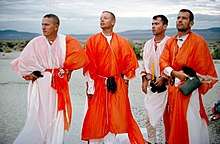
A lawyer, Henry Batten, agreed to negotiate a deal for their personal stories with Field Enterprises along the lines of the Life magazine deal enjoyed by the Mercury Seven, for no fee. As with the Life deal, there was some disquiet about the propriety of astronauts cashing in on government-created fame, but Mercury Seven astronaut John Glenn intervened, and personally raised the matter with Kennedy, who approved the deal.[47] The deals with Field and Time Life earned each of the nine $16,250 (equivalent to $137,000 in 2019) per annum over the next four years, and provided them with $100,000 life insurance policies (equivalent to $845,000 in 2019). Due to the dangerous nature of an astronaut's job, insurance companies would have charged them unaffordably high premiums.[53]
As Slayton was busy with Project Gemini, he delegated the task of supervising the Next Nine's training to Mercury Seven astronaut Gus Grissom.[47] Initially, each of the astronauts was given four months' of classroom instruction on subjects such as spacecraft propulsion, orbital mechanics, astronomy, computing, and space medicine. Classes were for six hours a day, two days a week, and all sixteen astronauts had to attend. There was also familiarization with the Gemini spacecraft, Titan II and Atlas boosters, and the Agena target vehicle.[54] Jungle survival training was conducted at the USAF Tropic Survival School at Albrook Air Force Station in Panama, desert survival training at Stead Air Force Base in Nevada, and water survival training on the Dilbert Dunker at the USN school at the Naval Air Station Pensacola in Florida and on Galveston Bay.[55]
Following the precedent set by the Mercury Seven, each of the Next Nine was assigned a special area in which to develop expertise that could be shared with the others, and to provide astronaut input to designers and engineers.[47] Armstrong was responsible for trainers and simulators; Borman for boosters; Conrad for cockpit layout and systems integration; Lovell for recovery systems; McDivitt for guidance systems; See for electrical systems and mission planning; Stafford for communications systems; White for flight control systems; and Young for environmental control systems and space suits.[56]
Legacy
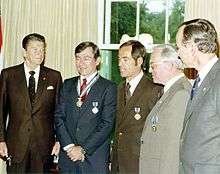
Collins wrote that in his opinion "this group of nine was the best NASA ever picked, better than the seven that preceded it, or the fourteen, five, nineteen, eleven and seven that followed."[57] Slayton felt so too, describing them as "probably the best all-round group ever put together."[58] The nine were deficient in only one respect: there was too few of them. Looking over the tentative schedule of Apollo missions, Slayton calculated that up to 14 three-person crews might be required, but the 16 astronauts on hand could fill just five. While he considered the schedule to be optimistic, he did not want a shortage of astronauts to be the reason the schedule could not be met, and therefore proposed that there be another round of recruiting.[59] On June 5, 1963, NASA announced that it was seeking another ten to fifteen new astronauts.[60]
The Next Nine went on to illustrious careers as astronauts. Apart from See and White, who were killed in a T-38 crash and in the Apollo fire, respectively, all went on to command Gemini and Apollo missions. Six of the nine flew to the Moon (Lovell and Young twice), and Armstrong, Conrad and Young walked on it as well.[61] Seven of the nine received the Congressional Space Medal of Honor for their service, valor, and sacrifice:[62]
- Armstrong, for commanding Apollo 11, the first lunar landing;[63]
- Borman, for commanding Apollo 8, the first crewed mission to the Moon;[63]
- Conrad, for commanding Skylab 2, and saving the damaged station;[64]
- Young, for commanding the first Space Shuttle mission, STS-1, in the Columbia.[65]
- Stafford, for commanding the international Cold War Apollo-Soyuz Test Project;[66]
- Lovell, for commanding the ill-fated Apollo 13;[67] and
- White, posthumously, killed in the Apollo 1 fire;[68]
Notes
- "All 'Original Seven' American astronauts now dead". phys.org. December 8, 2016. Retrieved May 5, 2019.
- Deiss, Heather (June 5, 2013). "Mercury – April 1959". NASA. Retrieved March 28, 2019.
- Burgess 2013, pp. 3–4.
- Brooks, Grimwood & Swenson 1979, p. 15.
- Hacker & Grimwood 2010, pp. 1–5.
- Burgess 2013, pp. 5–6.
- Grissom, Gus (February 1963). "The MATS Flyer Interviews Major Gus Grissom". The MATS Flyer (Interview). Interviewed by John P. Richmond, Jr. Military Air Transport Service, United States Air Force. pp. 4–7. Retrieved June 28, 2020.
- Atkinson & Shafritz 1985, p. 10.
- Slayton & Cassutt 1994, pp. 118–119.
- Weitekamp, Margaret A. (January 28, 2010). "Lovelace's woman in space program". NASA. Retrieved May 6, 2019.
- "More Astronauts to be Picked Soon" (PDF). NASA Roundup. 1 (12). April 4, 1962. Retrieved May 6, 2019.
- Burgess 2013, pp. 10–11.
- Stafford & Cassutt 2002, p. 36.
- Borman & Serling 1988, pp. 87–88.
- Hansen 2012, pp. 195–197.
- Burgess 2013, p. 7.
- Burgess 2013, pp. 32–33.
- Burgess 2013, p. 343.
- Kluger & Lovell 1995, pp. 180–183.
- Burgess 2013, pp. 37–40.
- Burgess 2013, p. 43.
- Burgess 2013, pp. 47–48.
- Burgess 2013, pp. 50–52.
- Slayton & Cassutt 1994, p. 120.
- Burgess 2013, pp. 62–63.
- Burgess 2013, pp. 64–66.
- Burgess 2013, p. 67.
- Burgess 2013, pp. 64–67.
- "Space: Nine More Astronauts". Time. September 28, 1962. Retrieved May 6, 2019.
- "MSC Names Nine New Pilot Trainees" (PDF). NASA Roundup. 1 (24). September 19, 1962. pp. 1, 4–5. Retrieved May 7, 2019.
- Burgess 2013, p. 54.
- Collins 2001, p. 42.
- Burgess 2013, pp. 145–147.
- Burgess 2013, pp. 147–149.
- Borman & Serling 1988, p. 102.
- Slayton & Cassutt 1994, pp. 136–138.
- Conrad & Klausner 2005, pp. 113–118.
- Burgess 2013, pp. 150–152.
- Burgess 2013, pp. 152–153.
- Burgess 2013, pp. 154–155.
- Hadhazy, Adam (August 10, 2015). "How fast could humans travel safely through space?". BBC. Retrieved May 7, 2019.
- Burgess 2013, pp. 155–156.
- Burgess 2013, pp. 156–158.
- Burgess 2013, pp. 158–159.
- Wolfe 1979, pp. 392–393.
- Koppel 2013, p. x.
- Slayton & Cassutt 1994, p. 123.
- Koppel 2013, pp. 103–104.
- Wolfe 1979, p. 396.
- Burgess 2013, p. 163.
- Wolfe 1979, pp. 396–398.
- Koppel 2013, pp. 110–111.
- Burgess 2013, p. 164.
- Burgess 2013, p. 165.
- Burgess 2013, pp. 170–174.
- Burgess 2013, pp. 166–167.
- Collins 2001, p. 32.
- Slayton & Cassutt 1994, p. 119.
- Slayton & Cassutt 1994, p. 132.
- Morse & Bays 1973, p. 61.
- "Apollo Astronauts". National Air and Space Museum. Retrieved May 8, 2019.
- "Congressional Space Medal of Honor". NASA. April 28, 2006. Retrieved May 5, 2019.
- "Kennedy Space Center, Florida Remarks at the Congressional Space Medal of Honor Awards Ceremony". The American Presidency Project. Retrieved May 8, 2019.
- "NASA Honors Apollo 12 Commander Charles Conrad". NASA. Retrieved May 8, 2019.
- "Remarks at a White House Luncheon Honoring the Astronauts of the Space Shuttle Columbia". The American Presidency Project. Retrieved May 8, 2019.
- Pearlman, Robert Z. (June 27, 2005). "Moon Rock to be Awarded to Apollo-Soyuz Astronaut Thomas Stafford". Space.com. Retrieved May 7, 2017.
- "Remarks on Presenting the Congressional Space Medal of Honor to James A. Lovell, Jr., and an Exchange With Reporters". The American Presidency Project. Retrieved May 8, 2019.
- "William J. Clinton: Remarks on Presenting the Congressional Space Medal of Honor Posthumously to Roger B. Chaffee and Edward H. White II". The American Presidency Project. Retrieved May 7, 2019.
References
- Atkinson, Joseph D.; Shafritz, Jay M. (1985). The Real Stuff: A History of NASA's Astronaut Recruitment Program. Praeger special studies. New York: Praeger. ISBN 978-0-03-005187-6. OCLC 12052375.CS1 maint: ref=harv (link)
- Borman, Frank; Serling, Robert J. (1988). Countdown: An Autobiography. New York: Silver Arrow. ISBN 0-688-07929-6. OCLC 17983615.CS1 maint: ref=harv (link)
- Brooks, Courtney G.; Grimwood, James M.; Swenson, Loyd S. Jr. (1979). Chariots for Apollo: A History of Manned Lunar Spacecraft. NASA History Series. Washington, D.C.: Scientific and Technical Information Branch, NASA. ISBN 978-0-486-46756-6. LCCN 79001042. OCLC 4664449. SP-4205. Retrieved July 20, 2010.CS1 maint: ref=harv (link)
- Burgess, Colin (2011). Selecting the Mercury Seven: The Search for America's First Astronauts. Springer-Praxis books in space exploration. New York; London: Springer. ISBN 978-1-4419-8405-0. OCLC 747105631.CS1 maint: ref=harv (link)
- Burgess, Colin (2013). Moon Bound: Choosing and Preparing NASA's Lunar Astronauts. Springer-Praxis books in space exploration. New York; London: Springer. ISBN 978-1-4614-3854-0. OCLC 905162781.CS1 maint: ref=harv (link)
- Collins, Michael (2001) [1974]. Carrying the Fire: An Astronaut's Journeys. New York: Cooper Square Press. ISBN 978-0-8154-1028-7. OCLC 45755963.CS1 maint: ref=harv (link)
- Conrad, Nancy; Klausner, Howard (May 2005). Rocketman: Astronaut Pete Conrad's Incredible Ride to the Moon and Beyond. New York: New American Library. ISBN 0-451-21509-5. OCLC 57311427.CS1 maint: ref=harv (link)
- Hacker, Barton C.; Grimwood, James M. (2010) [1977]. On the Shoulders of Titans: A History of Project Gemini (PDF). NASA History Series. Washington, D.C.: NASA History Division, Office of Policy and Plans. ISBN 978-0-16-067157-9. OCLC 945144787. NASA SP-4203. Retrieved April 8, 2018.CS1 maint: ref=harv (link)
- Hansen, James R. (2012). First Man: The Life of Neil A. Armstrong. New York: Simon & Schuster. ISBN 978-1-4767-2781-3. OCLC 1029741947.CS1 maint: ref=harv (link)
- Kluger, Jeffrey; Lovell, Jim (July 1995). Lost Moon: The Perilous Voyage of Apollo 13. New York: Pocket Books. ISBN 0-671-53464-5. OCLC 1053909345.CS1 maint: ref=harv (link)
- Koppel, Lily (2013). The Astronaut Wives Club. New York: Grand Central Publishing. ISBN 1-4555-0325-8. OCLC 816563627.CS1 maint: ref=harv (link)
- Morse, Mary Louise; Bays, Jean Kernahan (1973). "The Apollo Spacecraft – A Chronology, Volume II: November 8, 1962 – September 30, 1964" (PDF). The NASA Historical Series. Washington, D.C.: NASA. NASA SP-4009. Retrieved May 8, 2019.CS1 maint: ref=harv (link)
- Slayton, Donald K. "Deke"; Cassutt, Michael (1994). Deke! U.S. Manned Space: From Mercury to the Shuttle. New York: Forge. ISBN 978-0-312-85503-1. OCLC 937566894.CS1 maint: ref=harv (link)
- Stafford, Thomas P.; Cassutt, Michael (2002). We Have Capture. Washington, D.C.: Smithsonian Institution Press. ISBN 978-1-58834-070-2. OCLC 829407543.CS1 maint: ref=harv (link)
- Swenson, Loyd S. Jr.; Grimwood, James M.; Alexander, Charles C. (1966). This New Ocean: A History of Project Mercury (PDF). The NASA History Series. Washington, DC: National Aeronautics and Space Administration. OCLC 569889. NASA SP-4201.CS1 maint: ref=harv (link)
- Wolfe, Tom (1979). The Right Stuff. New York: Farrar, Straus, and Giroux. ISBN 978-0-553-27556-8. OCLC 849889526.CS1 maint: ref=harv (link)